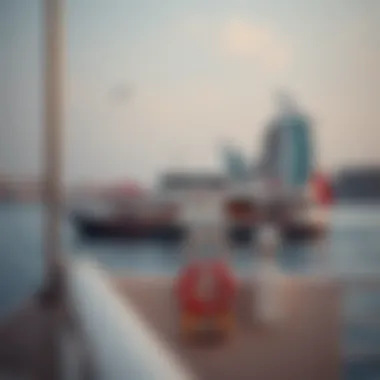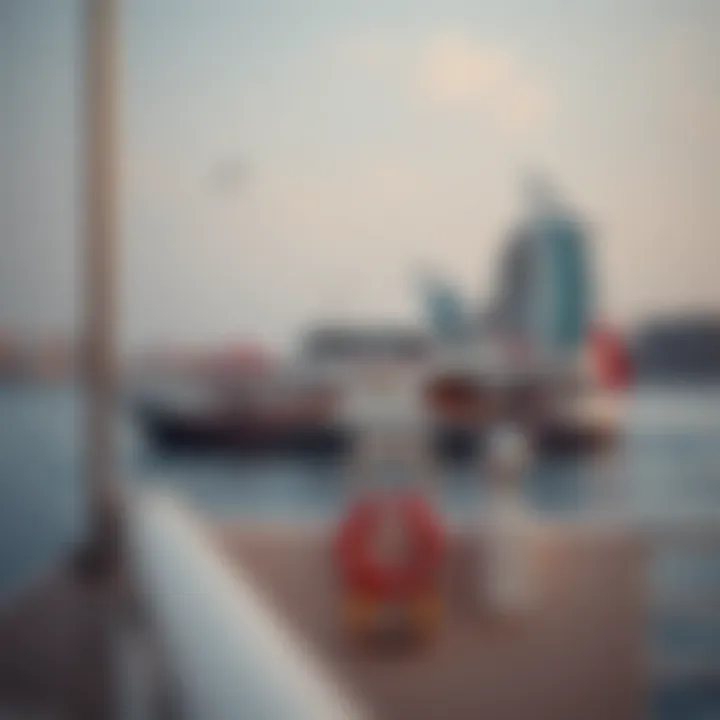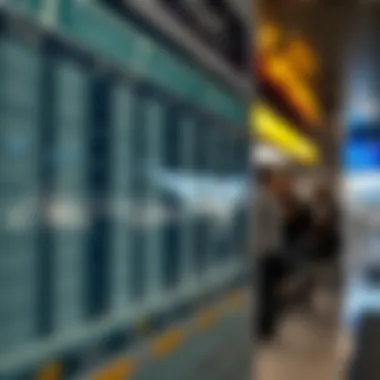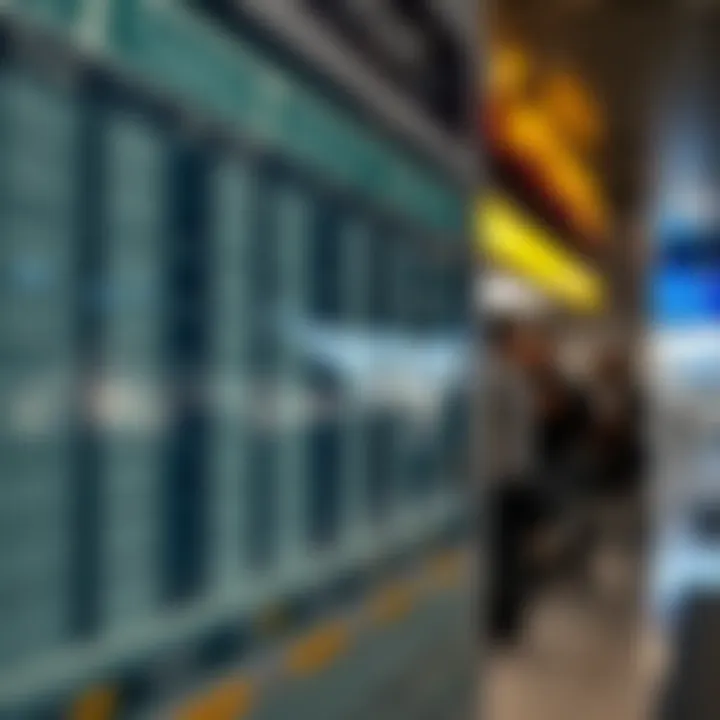Dubai RTA Ferry Timings: A Comprehensive Guide


Intro
Navigating the vast networks of transport in Dubai can be quite the endeavor, especially with the bustling city life and the splendid waterways that crisscross this modern marvel. Public transport is more than just a means of getting from point A to point B; it’s an integral part of the lifestyle here. Among the various options, the Dubai RTA ferry system stands out not only for its practicality but also for the unique experience it offers.
For both residents and visitors alike, knowing the operational timings of the RTA ferry becomes essential. This guide will take you through all the nitty-gritty details you need to plan your journey effectively—whether it’s hopping on for a quick trip or a leisurely cruise along the water.
No matter if you’re an investor, a homeowner, or just someone eager to soak in the beautiful skyline while on the ferry, a solid grasp of ferry timings, routes, and schedules can make all the difference.
Let’s dive into the key insights and practical information surrounding the Dubai RTA ferries, ensuring you’re well-equipped to navigate these waters with ease.
Intro to Dubai RTA Ferries
The Dubai RTA ferry system plays a crucial role in shaping the transport landscape of this vibrant city. With its stunning coastline and sprawling waterways, Dubai offers not only a unique way to explore the city but also an efficient means of transport. Ferries provide a scenic alternative to traditional road transport, allowing passengers to glide across the waters while enjoying picturesque views of the skyline and natural scenery.
Overview of the RTA Ferry System
The Road and Transport Authority (RTA) of Dubai established the ferry system to enhance connectivity while promoting an environmentally friendly transport option. Comprising several routes that span key waterfront locations, the ferry system serves as an integral part of Dubai's public transport network.
This expansive system includes vessels that can accommodate large groups, providing an accessible means of travel for both residents and visitors alike. The ferries offer several amenities such as comfortable seating and a requisite safe environment. This service not only highlights the architectural marvels of Dubai but also acts as a practical solution to manage the ever-growing vehicular traffic in the city.
While the ferry lines are popular for their functionality, they also serve as a unique vantage point for sightseeing. Imagine sipping your coffee while passing the Burj Al Arab or watching the sunset over the Dubai Marina. That’s the appealing experience that the RTA ferry system offers.
Significance of Water Transport in Dubai
Water transport is particularly significant in an urban area like Dubai, which boasts a complex network of waterways. It helps ease congestion on the roads, providing alternative routes that can save time.
Moreover, the ferries are an essential link connecting various districts and tourist attractions. Here are some key reasons why water transport holds importance in Dubai:
- Efficient Travel: In some cases, taking a ferry can reduce travel time significantly compared to road routes, especially during peak hours when traffic can be heavy.
- Tourist Attraction: The allure of water transport draws tourists, making it an appealing choice for exploring the city.
- Environmental Benefits: By promoting the use of ferries, Dubai continues to invest in sustainable transport options that help reduce air pollution.
In summary, the RTA ferry system not only enriches the transport offerings in Dubai but also enhances the overall experience of navigating this spectacular city.
Understanding Ferry Timings
The timing of ferry operations in Dubai plays a crucial role in daily transportation, especially in a city where multiple transit options are available. Understanding these timings allows residents and tourists alike to leverage the ferry's connectivity, ensuring efficient journeys across the waterways. The RTA ferry system is not just about crossing water; it represents an urban solution to managing traffic, enhancing accessibility, and connecting neighborhoods.
Being knowledgeable about the schedules offers several advantages. For one, it helps commuters plan their trips better, reducing wait times and increasing overall convenience. For businesses, knowing ferry timings can also impact foot traffic to commercial areas nearby ferry stations. It’s no secret that folks who keep a close watch on transportation schedules can make the most of their time, whether for work or leisure.
Additionally, understanding ferry timings assists in avoiding rush hours, enabling a more relaxed travel experience. Commuters can choose to travel during less busy periods, leading to a less stressful outing. Furthermore, as water transport becomes increasingly popular in urban settings, grasping the timing fundamentals becomes critical for coastal infrastructure users.
Regular Operating Hours
The RTA ferry service operates on a consistent timetable, designed to accommodate a range of passenger needs throughout the day. Generally, the ferries run from early morning until late at night, allowing both locals and tourists to take advantage of this transport method.
- Morning Hours: Ferries usually start operations around 6:30 AM, catering to early risers looking to head to work or start their day. This time is essential for commuters who rely on public transport to navigate Dubai’s often busy roadways.
- Midday Operations: During the peak hours, which include mid-morning and lunchtime, the ferries adjust their schedules to meet increased demand. Additional trips might be available to accommodate those heading to popular business districts for meetings or shopping.
- Evening and Night Service: The last ferries typically run until about 11:00 PM, providing a handy option for those enjoying the evening entertainment along the waterfront. Whether it's dining by the bay or engaging in cultural activities, the ferry offers a scenic departure.
Regular perusal of the ferry schedules available on the RTA's official website can benefit all travelers. Staying informed allows one to avoid surprises and makes for smoother travel plans.
Peak vs. Off-Peak Times
Recognizing peak and off-peak times is pivotal for anyone utilizing the Dubai RTA ferry service. Peak hours are usually aligned with typical work schedules, with the highest passenger loads observed in the mornings and late afternoons. Knowing these times can significantly inform a passenger's travel strategy.
- Peak Times: Primarily from 7:00 AM to 9:00 AM and from 5:00 PM to 7:00 PM on weekdays, ferry operations may see a full house. With corporate workers commuting, these slots tend to fill up rapidly. Therefore, if one is looking for a more leisurely ride, it’s advisable to either travel well before or after these times.
- Off-Peak Times: Conversely, traveling during off-peak times can guarantee a more comfortable journey. Generally, this would be mid-morning, early afternoon, and late evening. During these intervals, ferries are less crowded, allowing passengers to relax and enjoy the views without the hustle and bustle.
Furthermore, scheduling flexibility can offer economic advantages. For example, limited ticketing discounts may apply when one chooses to travel during off-peak hours.


Overall, understanding ferry timings isn’t merely about compliance; it’s an exercise in urban savvy. Knowledge brings finesse to travel plans, reducing stress and enhancing experiences as you navigate Dubai's urban landscape.
Ferry Routes and Destinations
The ferry routes in Dubai are more than just a mode of transport; they are a vital link in the city's bustling network. These routes serve not only tourists eager to explore the sparkling shores of the emirate but also residents who utilize the ferry system for daily commuting. Understanding these routes and their significance is paramount for anyone looking to navigate Dubai efficiently.
Popular Ferry Routes
Dubai's ferry system boasts several popular routes that carve a path across its picturesque waterways. One of the most frequented routes is the one connecting Dubai Marina to the iconic Dubai Mall. This route provides a scenic view of the city's stunning skyline and allows passengers to experience the glamour of both areas.
Another notable route sails from Al Ghubaiba to the serene Palm Jumeirah. This journey offers passengers a breathtaking perspective of the palm fronds extending into the Arabian Gulf. For those near the Bur Dubai area, the route to Dubai Creek is well-known among locals and is a great way to experience traditional Dubai amidst modern marvels.
Here’s a brief overview of some of these routes:
- Dubai Marina to Dubai Mall: A scenic journey perfect for tourists.
- Al Ghubaiba to Palm Jumeirah: Ideal for leisurely visitors wanting to explore.
- Bur Dubai to Dubai Creek: A cultural journey showcasing the heritage of the city.
While many tourists flock to these routes, they also play a crucial role in alleviating road congestion, especially during rush hours. Therefore, the ferry system is essential not only for its aesthetic value but also for its contribution to urban mobility in the region.
Connecting Key Locations
The connectivity offered by the RTA ferry routes significantly enhances the public transportation landscape in Dubai. Each ferry stop acts as a hub, connecting to various modes of transport, including buses and metro lines.
For instance, the Dubai Marina ferry station is equipped with services that connect to the metro, allowing easy access for commuters traveling from further afield. Likewise, the Al Ghubaiba Ferry Station seamlessly links to major bus routes. This interconnectedness simplifies the transit experience, making it more user-friendly, especially for foreign visitors possibly grappling with an unfamiliar transport system.
Also, some ferry locations are strategically placed near shopping districts and entertainment spots, further enhancing their appeal. For example, ferries docking at the Dubai Mall provide a grand arrival for shoppers who wish to avoid traffic.
To summarize:
- The RTA ferry routes serve as crucial connections in Dubai’s public transport network.
- Key ferry stations are well-linked to other transport systems, including buses and metro.
- Enhances convenience for commuters and tourists alike.
In essence, these ferry routes are not just paths across the water but arteries of convenience that enhance the overall experience of navigating Dubai’s urban landscape.
Seasonal Changes in Schedule
Understanding the seasonal changes in the RTA ferry schedule is pivotal for anyone looking to navigate Dubai's unique waterways. These adjustments reflect the varying demands throughout the year, shaped largely by visitor patterns, climate conditions, and public sentiment toward outdoor activities. Staying informed on these shifts not only supports effective planning but also enhances accessibility for both tourists and residents who rely on ferry transport.
Summer Operating Adjustments
During the sweltering months of summer, which typically span from June to September, the RTA has to rethink its entire ferry timetable. With temperatures soaring, many people prefer to be out and about during the early mornings or later in the evening when it’s cooler. This seasonal shift manifests in several ways:
- Reduced Operating Hours: Ferries may start running later in the morning and close operations earlier in the evening, catering to the cooler hours.
- Extended Service Intervals: The frequency of ferries might be less during the peak when locals shy away from outdoor activities. Yet, special services could be added during evenings to accommodate night-travelers and the bustling Dubai nightlife.
- Increased Capacity for Tourists: The summer surge in tourism leads to the possibility of larger vessels to handle higher passenger numbers on popular routes, like the Dubai Marina to Jumeirah Beach.
Overall, it's wise for passengers to check specific ferry times during the hot months to ensure efficient travel.
Winter Schedule Modifications
As the days cool down and Dubai embraces the winter months, typically between October and March, the ferry service often sees an uptick in operations. The serene weather invites a greater number of locals and tourists to explore the waterfront. This leads to important schedule modifications:
- Longer Operating Hours: Ferries typically begin earlier in the day and operate later into the evening, capitalizing on the pleasant weather and increasing demand.
- Higher Frequency: When the influx of tourists peaks, especially around holidays or festivals, you’ll find ferries departing more regularly to accommodate the bustling crowds. Coastal events can lead to additional services that's a treat for visitors.
- Themed or Special Services: During the cooler months, the RTA sometimes launches special themed ferry rides, which can attract both locals and tourists for unique experiences on the water.
These adjustments reflect an overarching trend of adapting to passenger needs, showcasing a responsiveness that fuels the popularity of the ferry system in Dubai.
In summary, being aware of these seasonal adjustments in the ferry schedule allows for better travel planning and enhanced enjoyment of what Dubai's waterways have to offer.
Ticketing Information


Navigating the Dubai RTA ferry system efficiently requires not just an understanding of the schedules but also familiarity with the ticketing process. Ticketing information is the backbone of travel in this aquatic network, serving as the bridge between the traveler and their destination. Knowing how to purchase tickets and what types are available can save time and ensure a smoother journey across the city’s waterways.
Types of Tickets Available
When it comes to ferry tickets in Dubai, travelers have a few options tailored to diverse needs. The basic ticket type is a one-way ticket, which is perfect for those looking to hop on and off the ferry at different stops. Beyond that, there are return tickets ideal for round trips.
For frequent ferry users, the RTA offers a special card called the Nol card. This smart card can be used not only on ferries but also on trams, buses, and metro services in Dubai, making it a versatile choice for commuters. Here are the main types:
- One-Way Ticket: Suitable for single trips.
- Return Ticket: Convenient for a quick journey back.
- Nol Card: A rechargeable smart card for various public transport modes.
Each ticket type has its purpose, helping different kinds of travelers move about with ease.
Pricing Structure
Understanding the pricing structure is essential for budget-conscious travelers. Ferry fares in Dubai are typically affordable, reflecting the city’s commitment to enhancing public transport access.
The fare for a one-way journey generally costs around 15 Dirhams, while a return ticket is slightly less than purchasing two individual tickets. The Nol card, on the other hand, offers discounted rates for regular users, making it an attractive option if you plan to travel frequently.
- One-Way Fare: Approximately 15 AED.
- Return Fare: Usually about 25 AED.
- Nol Card Discount: Reduced fares based on usage.
Such affordability ensures that taking the ferry remains a viable option for residents and tourists alike, further promoting water transport as a sustainable urban alternative.
Where to Purchase Tickets
Acquiring your ferry ticket is straightforward. Travelers can buy tickets at various locations, ensuring convenience. Ticket vending machines are available at ferry terminals along with customer service counters manned by staff who can assist with any inquiries.
For those opting for the Nol card, it can be purchased at any metro station or authorized retailers throughout the city. Moreover, the RTA app provides a digital avenue for purchasing and managing tickets, appealing to tech-savvy users who prefer to handle transactions via their smartphones. Here’s a quick rundown of where to snag your ferry tickets:
- Ferry Terminals: Ticket machines and service counters.
- Metro Stations: Nol cards and tickets can be purchased.
- Retail Outlets: Authorized stores across Dubai.
- RTA Mobile App: Digital ticket purchases on-the-go.
"Access to affordable and convenient tickets contributes significantly to encouraging the use of public transport, ultimately relieving road congestion and supporting sustainable urban transportation in Dubai."
In summary, having detailed knowledge about ticketing, including ticket types, pricing, and where to purchase them, is not just helpful; it’s crucial for a seamless experience traveling via the Dubai RTA ferries.
Travel Tips for RTA Ferry Users
Navigating the waterways of Dubai can be both an adventure and a practical means of transport for many residents and visitors. However, to make the ferry experience as pleasant as possible, it’s important to follow a few essential travel tips. These suggestions not only emphasize best practices but also cover managing personal items while onboard, ensuring that your journey flows smoothly.
Best Practices for Timely Arrival
Timeliness is crucial when using the RTA ferry services. Given that ferries run on a schedule, late arrivals can lead to missed connections or lengthy waits. Here are some recommendations for making sure you hit the right boat:
- Plan Your Journey: Before setting out, check the ferry schedule provided by the Roads and Transport Authority. Knowing the timings will allow you to allocate enough time to get to the station.
- Arrive Early: Aim to arrive at least 15 to 30 minutes prior to your desired departure. This buffer helps in case of unexpected delays, such as traffic or searches that may slow you down.
- Know Your Route: Familiarize yourself with the ferry route and landing points. This knowledge will enable you to choose the most convenient ferry based on your travel needs.
By adhering to these practices, you can avoid the stress of rushing and make the most of your ferry ride.
Managing Luggage and Personal Items
Bringing along your personal belongings doesn’t have to become a hassle if you manage them effectively. Here are some vital considerations when it comes to luggage and personal items:
- Luggage Restrictions: The RTA ferry allows a reasonable amount of luggage per passenger, but be aware of their limitations. If you're traveling with larger bags, consider minimizing the number of items you carry.
- Secure Your Belongings: As you step onto the ferry, make sure to keep your personal belongings close to you. Use luggage straps or locks for piece of mind. It's better to be cautious than sorry.
- Use Storage Spaces Wisely: Ferries typically have designated storage areas for bags. Utilize these spaces but keep your valuables with you. Having a designated backpack for personal items can help keep things organized and fortuitously accessible.
Thinking ahead about your belongings can save you time and concern during your trip.
Onboard Amenities and Services


While aboard an RTA ferry, several amenities enhance the commuter experience. Understanding what’s available can help you be prepared and make the most of your journey:
- Seating Options: Ferries are equipped with comfortable seating arrangements. Some may prefer outdoor seating for fresh air and stunning views of Dubai's coastline, while others may seek shelter indoors.
- Wi-Fi Services: Many ferries offer complimentary Wi-Fi, presenting an excellent opportunity to catch up on emails or share pictures of your trip on social media.
- Refreshments: Depending on the ferry, some provide small cafes or kiosks with light snacks and drinks. If you’re planning for a longer journey, consider grabbing a treat beforehand to enjoy it while you travel.
By knowing the available services, you can settle in and enjoy the raod before you, making your ride more pleasant.
"Planning ahead and being aware of your surroundings enhances the ferry experience and ensures a smooth trip from start to finish.”
These travel tips are designed to empower RTA Ferry users to optimize their commuting experience while embracing the unique voyage along Dubai's waterways.
Alternatives to the RTA Ferry
While the Dubai RTA ferry system is a notable choice for many commuters and tourists, it’s important to recognize that alternatives exist. These options cater to various preferences, budgets, and time constraints, allowing individuals to navigate the city’s stunning waterways and urban landscapes in other ways. This section will explore these alternatives, highlighting their benefits and considerations, ensuring that travelers can make the best possible choice based on their needs.
Comparison with Other Public Transport Options
Dubai boasts a well-integrated public transport system, including metro services, buses, and trams. Here's a closer look:
- Dubai Metro: This is one of the fastest ways to traverse the city. The Metro has stations linking major districts, and it’s often preferred for its speed and efficiency. However, it does not provide direct access to waterfront areas like the ferry.
- Buses: Covering a broad network across Dubai, buses are cost-effective. They complement the ferry system by connecting various ferry stations to different parts of the city, although they are typically slower.
- Trams: Operating primarily in the Dubai Marina and Jumeirah Beach Residence (JBR), trams offer convenient access to popular destinations. They can be a great addition if your journey involves switching between different modes of transport.
Considerations for choosing among these options include:
- Time Efficiency: If you need to reach a destination quickly, the Metro is likely your best bet.
- Cost: Buses are less expensive than ferries or trains, making them an ideal choice for budget-conscious travelers.
- Accessibility: Depending on where you are in Dubai, certain public transport might offer better proximity.
Overall, the best choice often depends on your specific route and what conveniences matter most to you.
Private Boats and Yachts
For those looking for luxury or a more tailored experience on the waters, private boats and yachts offer an enticing alternative. Whether you're arranging a special occasion, business meeting, or simply a unique sightseeing tour, these options provide flexibility like no public transport can.
- Customized Routes: Unlike the ferry, private boats can take you exactly where you want, whether it’s a secluded beach, an island, or around the glittering coastline.
- Exclusive Amenities: Many private boats and yachts come with luxury features such as catering, air conditioning, and private bathrooms, providing a level of comfort that enhances the experience.
- Social Events: Hosting parties or corporate events onboard is popular in Dubai. The stunning skyline and picturesque sunsets create an unforgettable backdrop.
- Cost Considerations: While renting a yacht can be pricey, many companies offer shared options, allowing groups to split the costs, making it more accessible.
Impact of the Ferry on Dubai's Urban Development
Dubai's rapid expansion and development have reshaped the city into a bustling hub of commerce, tourism, and culture. Within this landscape, the Dubai RTA ferry system plays a pivotal role, intertwining with the city's growth trajectory. The integration of ferries into the public transport network has not only transformed the way residents and visitors navigate the waterways but has also prompted far-reaching benefits in urban development and real estate.
Integration within the Public Transport Network
The RTA ferry system connects seamlessly with other modes of public transport, creating a well-rounded transit solution for those in Dubai. Lines that connect to metro stations and bus routes help ferry passengers to transition smoothly between aerial and terrestrial transportation. This form of connectivity is crucial for easing congestion on roads, a common issue in fast-paced urban environments.
For example, the ferry terminal at Dubai Marina provides direct access to the Metro station, facilitating easy travel to the bustling downtown area. With its frequent schedules, this connectivity allows commuters to abandon their cars more freely, reducing their overall carbon footprint. In essence, the ferry contributes to a comprehensive transportation network that brings people closer to their destinations, thereby promoting a more sustainable urban ecosystem.
Culmination
The overall discussion surrounding Dubai's RTA ferry system highlights more than just convenience in personal commuting. It serves as a vital artery that connects various points of interest throughout the vibrant city, enhancing both daily life and tourism. This unique mode of transportation not only beautifies the urban landscape but also plays a significant role in urban planning by reducing vehicular congestion and promoting sustainable transport.
Final Thoughts on Utilizing the Ferry System
Utilizing the RTA ferry can be a pleasurable experience for both locals and newcomers. The interplay between water transport and the urban fabric of Dubai offers several advantages. For instance, travelers can enjoy breathtaking views while avoiding the often chaotic street traffic. This experience goes beyond mere transport; it's an opportunity to engage with Dubai’s scenic waterfront scenery.
Benefits of Using the Ferry:
- Time-Efficiency: Ferries generally run on a strict schedule. By planning your journey, you can transform what might be a lengthy car ride into a leisurely boat trip.
- Cost-Effective: Compared to taxis or car rentals, ferry fares tend to be more reasonable, making them an appealing choice for budget-conscious travelers.
- Access to Natural Beauty: The ferry routes offer a vantage point to admire the iconic skyline, parks, and residential developments lining the coast.
However, it is essential to consider factors such as peak times, which can be busier, especially on weekends or holidays. Keeping an eye on seasonal schedules can also enhance your travel experience, as the services adapt to the changing demands of boat traffic.
"Navigating through water is not just about getting from point A to point B. It’s about embracing the journey, the sights, and the community around you."
For those contemplating the purchase of real estate or engaging in property development near ferry stations, the increased accessibility can be a significant boon. Investing in areas with good ferry connectivity speaks to foresight, aligning with the trends of urban mobility that prioritize sustainable and efficient transport options.
Overall, embracing the ferry system leads not only to personal gains but also contributes to a more interconnected and attractive urban environment. It’s not just transport; it’s a way of seeing the city and understanding its pulse.















